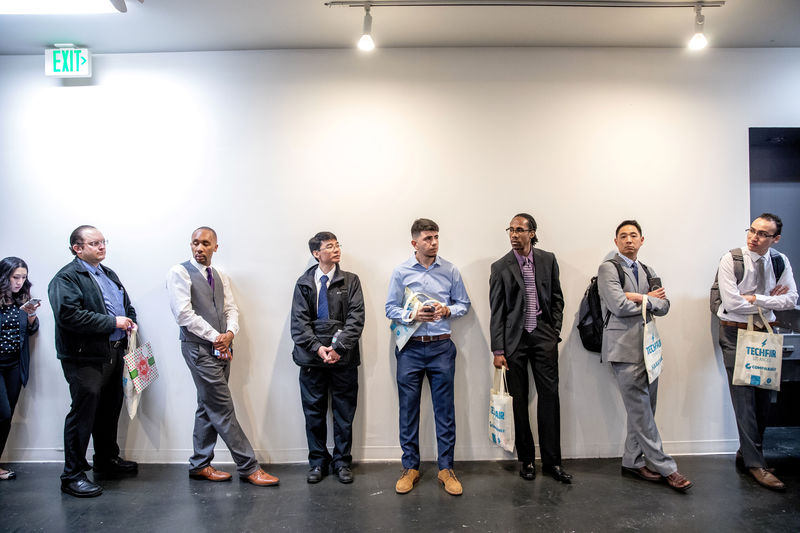By Lucia Mutikani
WASHINGTON (Reuters) - The number of Americans filing applications for unemployment benefits fell to more than a 49-year low last week, but the drop likely overstates the health of the labor market as claims for several states including California were estimated.
Still, labor market conditions remain strong, which for now should help to temper fears of a sharp slowdown in economic growth. Other data on Thursday showed a gauge of future U.S. economic activity fell in December.
The economy is facing several headwinds, including a bitter U.S. trade dispute with China and a month-long partial shutdown of the federal government, which are hurting consumer and business confidence. Higher interest rates, fading fiscal stimulus and cooling global economies are also seen crimping domestic growth.
"If you're looking for good news on the economy, look no further than the labor market," said Jim Baird, chief investment officer at Plante Moran Financial Advisors in Kalamazoo, Michigan. "Growth may be slowing, but the overall picture for workers and those seeking work remains quite positive."
Initial claims for state unemployment benefits dropped 13,000 to a seasonally adjusted 199,000 for the week ended Jan. 19, the lowest level since mid-November in 1969 when 197,000 applications were recorded, the Labor Department said.
Economists polled by Reuters had forecast claims rising to 220,000 in the latest week. The Labor Department said claims for California, Kansas, North Dakota, Virginia, West Virginia and Hawaii were estimated last week because of Monday's Martin Luther King holiday.
The four-week moving average of initial claims, considered a better measure of labor market trends as it irons out week-to-week volatility, fell 5,500 to 215,000 last week.
About one-quarter of federal agencies have been shuttered since Dec. 22, impacting 800,000 government employees, with many working without pay and others furloughed. All workers will be paid retroactively when the shutdown ends.
But economists expect the longest shutdown in history will push the unemployment rate above 4.0 percent in January as the furloughed workers would be considered unemployed.
The jobless rate rose two-tenths of a percentage point to 3.9 percent in December as strong labor market conditions attracted some unemployed people back into the labor force.
Stocks on Wall Street were trading mixed after U.S. Commerce Secretary Wilbur Ross said Washington and Beijing were a long way from resolving their trade dispute. The dollar was stronger against a basket of currencies, while prices of U.S. Treasuries rose.
DATA VACUUM
Thursday's claims report showed the number of people receiving benefits after an initial week of aid decreased 24,000 to 1.71 million for the week ended Jan. 12. The so-called continuing claims data covered the week of the household survey from which January's unemployment rate will be calculated.
Continuing claims rose 5,000 between the December and January survey periods. If there were no government shutdown, the modest gain between the survey weeks would suggest little change in the unemployment rate this month.
The number of federal workers filing for jobless benefits rose 14,965 to 25,419 in the week ending Jan. 12.
President Donald Trump is demanding $5.7 billion to build a wall along the U.S. border with Mexico. Democratic lawmakers have refused to provide the funding for the wall.
The Commerce Department is one of the agencies whose funding has lapsed as a result of the deadlock in Washington.
The publishing of data produced by the department's Bureau of Economic Analysis and Census Bureau has been suspended, leaving economists, investors, businesses and policymakers in the dark about the economy's health.
The limited data available from independent institutions, including the Federal Reserve suggests the economy slowed in the fourth quarter and continued to lose momentum in early 2019.
In a separate report on Thursday, the Conference Board said its leading indicator slipped 0.1 percent in December after gaining 0.2 percent in November. It said the moderation suggested "that the economy could decelerate towards 2 percent growth by the end of 2019."
The report adds to recent data showing home resales plummeting in December and consumer sentiment tumbling to more than a two-year low in January. Some regional Fed manufacturing surveys have weakened in January.
While a third report on Thursday from data firm IHS Markit showed factory activity firming in early January, growth in the services sector slowed. Economists estimate the government shutdown is subtracting at least two-tenths of a percentage point from quarterly GDP growth every week.
"Although three-quarters of the government is funded for the fiscal year, delays in government contracts for the remaining unfunded agencies could hurt private contractors," said Maria Cosma, an economist at Moody's Analytics in West Chester, Pennsylvania.

Some Wall Street banks, including JPMorgan (NYSE:JPM) and Barclays (LON:BARC), have slashed their first-quarter GDP growth forecasts to as low as a 2.0 percent annualized rate from as high as a 3.0 percent pace. Growth estimates for the fourth quarter are around a 2.8 percent rate. The economy grew at a 3.4 percent pace in the July-September quarter.